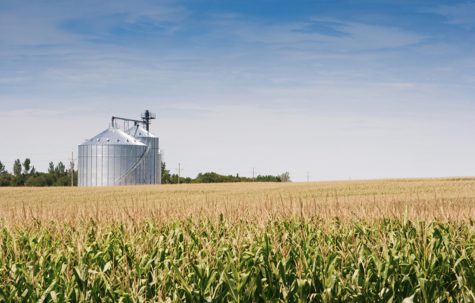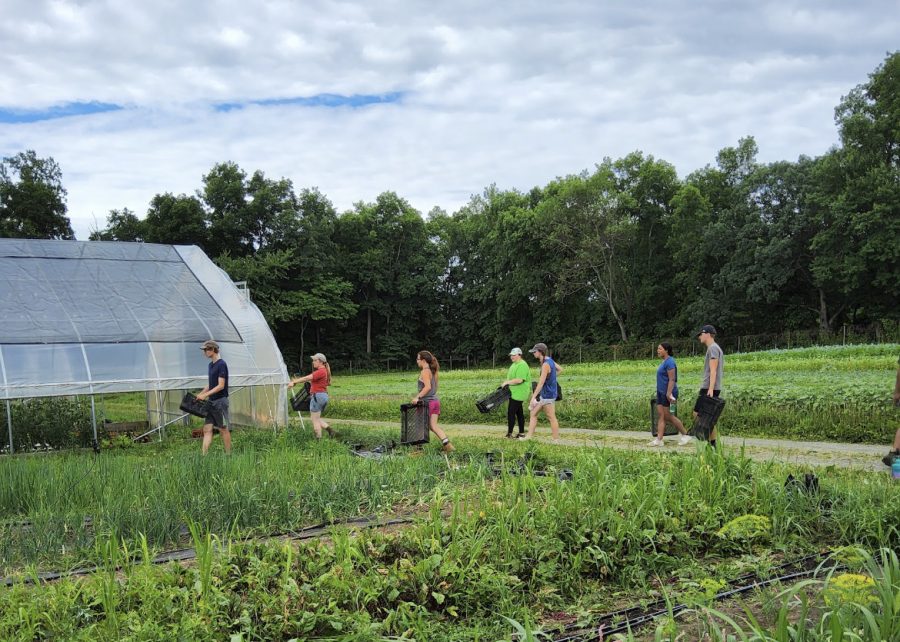Orosz: Shed the Blindfold and Thank Your Local Farmer
Farms work hard every day, no matter the weather, to provide food for the country. Despite efforts, many don’t know where their food comes from and have lost touch with their local farmers.
February 13, 2023
WOODBURY — Hey mom, where does cereal come from? The grocery store, son.
Here we go again, the cycle is repeating itself. With nearly 48% of Americans saying they never seek out where their food comes from or how it is grown according to Michigan State University, the problem persists.
People today don’t know where their food comes from, who grew it, or the time and labor put into producing it.
According to the U.S. Department of Agriculture, in 2021, agricultural workers make up approximately 10.5% of the total U.S. employment.
With this, you’d think that every person in the country would know a farmer, rancher, or other agricultural worker.
Apparently not.
With Generation Z being oblivious, and the most impacted by this due to the ignorance of parents not teaching their children, and that cycle repeated for generations, it’s clear that everyone is clueless.
An online survey from the Innovation Center of U.S. Dairy included the following results: “orange juice was voted as America’s favorite fruit,” “40% of California students from 4th-6th grade didn’t know hamburgers came from cows,” and my personal favorite, “16 million people think chocolate milk comes from brown cows.”
This is laughable, and honestly embarrassing.
News outlets haven’t shied away from enlightening the public with the Washington Post stating, “Today, many Americans only experience food as an industrial product that doesn’t look much like the original animal or plant.”
Just like the boy I mentioned before with the cereal, many don’t understand that ketchup comes from tomatoes, bacon comes from pigs, or even popcorn comes from actual corn.
This isn’t fully a problem for the youth; it comes from the environment people live in.
“I think [people don’t know where their food comes from] because the majority of humans live in urban areas, and unless they work within the [food manufacturing industry], most people don’t see how the process of making refined food happens, like how wheat crop comes from the fields and turned into flour,” said Hali Taylor, a farmer at Massaro Farm in Woodbridge.
“People [today] largely access their food from grocery stores, or if they are in a food desert (when people in urban areas live more than 0.5 miles from a grocery store or people in rural areas live more than 10 miles away), from gas stations or fast food/convenience stores, making them far removed from seeing the farm, or anything resembling a vegetable at that point,” added Taylor.
Despite many not seeing the original product, farmers work hard to provide for the country, with many unaware of what they do.
“In the summer, I work anywhere from 60 to 80 hours a week, eight to 11 hours a day, in the heat and rain, no matter what,” said Michael LaFauci, a Nonnewaug senior and farmer at Kalenauskas Farm in Watertown.
These long hours come with the responsibility of providing the raw ingredients needed for the survival of society, even with the challenges of increasing costs.
“Costs are high for fertilizer; you don’t always get the money back that you put into it,” said LaFauci. “We put a lot of resources into planting a crop and sometimes things don’t work out. Droughts and floods can make it even harder to produce expected yield, which can also drive up the prices.”
According to FarmDoc Illinois, the price of fertilizer for corn was $175 per acre in 2021, and it climbed to $247 per acre in 2022.

Randy Kron, an Indiana farmer, told the Indy Star that he paid $480 a ton for nitrogen in 2021 and paid $1,520 for the same in 2022.
“I am actually more concerned about the 2023 crop than the 2022 crop,” Kron additionally told the Indy Star in early 2022.
Kron correctly projected the 2022 crop’s inflation, as prices rose 9.9% according to the USDA due to drought, floods, and the economy. It was difficult for farmers to stay afloat, leaving many wanting support from their local communities.
“I wish people cared more and supported smaller local farms. With the government driving up prices, it is making it harder for farmers to survive,” added LaFauci.
These prices are expected to climb in 2023, making it even more difficult for farmers to provide affordable prices for their crops, causing a larger disconnect between farmers and consumers.
In order to bridge the gap, education is key. Many things can be done to promote ag literacy, which in turn will ensure more Americans understand where their food comes from and how it turns from an apple to apple juice and more.
Some farmers remain doubtful that the public will remain unaware.
“Corn has to go through a lot to become a Dorito. If someone has no reason that they know of to learn about something, why would they? It’s hard to know about farms when you’ve never experienced one,” said Taylor.
This basic understanding of the agricultural industry can be done by visiting your local farm stand, and getting to know the farmers and other workers on the property.
For the youth, agricultural education can be made simple by sitting in on or joining your local 4H club or FFA chapter.
These tasks, although daunting at first, can help educate current and future generations about farms, farmers, and how their food came to their table.
“Knowing where your food comes from can change your life,” stated Alice Waters, an American chef.
This is the opinion of Chief Advocate ag/FFA editor Madelynn Orosz.



















